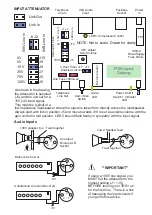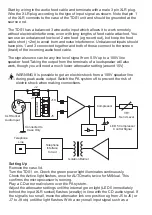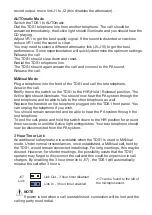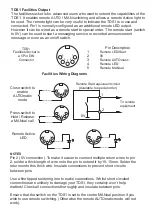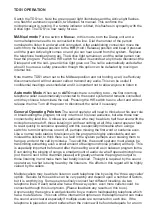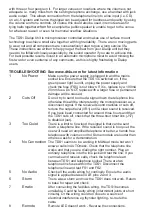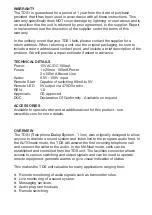
with three or four people in it. For larger venues or locations where the volume is not
adequate i.e. many miles from the serving telephone exchange, use a handset with jack
audio output. This allows connection from the telephone line into a line input (i.e. CD)
on a hi-fi system and hence the signal can be adjusted for loudness and quality by using
the volume and tone controls. Of course this could
also be used in remote areas for
tying halls together
when for
example the public speaker is unable to get to the venue
for whatever reason or even for memorial overflow situations.
The TDS1 Dialup Unit is microprocessor controlled and makes use of surface mount
technology to achieve small size together with high reliability. There are no moving parts
to wear out and all components are conservatively rated to give a long service life.
These instructions are written to help you get the best from your Dialup unit but they
need to be followed closely especially by the sound operator if you are to achieve this.
For best possible results, invest in an automatic microphone mixer to avoid missing the
first word or even sentence of any comments, as this is highly frustrating to Dialup
users.
TROUBLESHOOTING See www.dt4u.com for latest information
1
No Power
Make sure the power supply is plugged in and the mains
socket live. Ensure that the TDS1 is switched on. If the
green power light is unlit, unplug the power supply and
check the fuse (FS5) is not blown. If it is, replace by a 100mA
20mm fuse. Do NOT replace with a larger fuse or permanent
damage will be caused.
2
Cuts Off
Do not try to send too loud a signal down the telephone line
otherwise this will be interpreted by the microprocessor as a
disconnect signal. If the received sound crackles or cuts off,
reduce the output level (VR1) until a clear sound is received.
If you have been connected for around three hours and then
the TDS1 cuts off, check that the three hour timer link (J17)
is disabled (out).
3
Too Quiet
There is a limit to how loud the signal is that can be sent
down a telephone line. If the received sound is too quiet, the
user will need an amplified telephone or better, a hands free
telephone with volume control. Some models are louder than
others so ask for a demonstration.
4
No Connection
The TDS1 seems to be working in MANual mode but won’t
answer calls in AUTOmatic. Check that the telephone line
works and that you are dialing the right number. Plug an
ordinary telephone into the line jack and test the line. If you
can make and receive calls, check the telephone lead
between TDS1 and telephone socket. There are two
telephone line fuses within the TDS1. Disconnect the
telephone line and test FS1 and FS2.
5
No Audio
Check all the audio wiring for continuity. Ensure the audio
signal is applied between XLR pins 2 and 3.
6
Storm
There was a storm and now the TDS1 does not work. Return
to base for repair and check.
7
Erratic
After connecting the facilities wiring, the TDS1 becomes
unreliable. Could be faulty wiring (intermittent joints or short
circuits). Or the wiring could run close to a source of
electrical interference eg thyrister lighting - re-route the
cable.
8
Remote
Remote LED doesn’t work - Reverse the connections.


